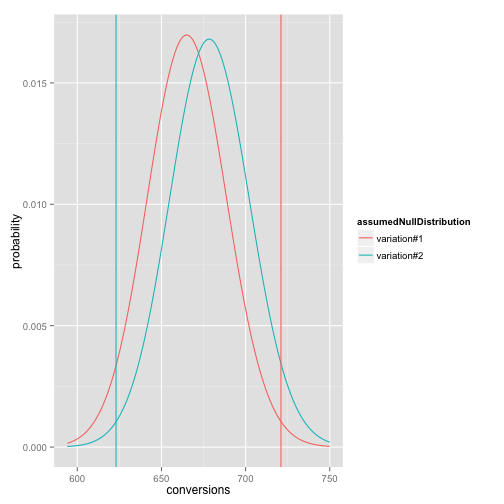
plot of chunk rateExample
# R example working a rate significance test related to the problem stated in http://blog.sumall.com/journal/optimizely-got-me-fired.html
# See: http://www.win-vector.com/blog/2014/05/a-clear-picture-of-power-and-significance-in-ab-tests/ for more writing on this
# Note: we are using exact tail-probability from the binomial distribution exactly. This is easy
# to do (as it is a built in function in many languages) and more faithful to the underlying
# assumed model than using a normal approximation (though a normal approximation is certainly good enough).
# to rebuild
# echo "library(knitr); knit('rateTestExample.Rmd')" | R --vanilla ; pandoc rateTestExample.md -o rateTestExample.html
# type in data
d <- data.frame(name=c('variation#1','variation#2'),visitors=c(3920,3999),conversions=c(721,623))
d$rates <- d$conversions/d$visitors
print(d)## name visitors conversions rates
## 1 variation#1 3920 721 0.1839
## 2 variation#2 3999 623 0.1558# For our null-hypothesis assume the two rates are identical.
# under this hypothesis we can pool the data to get an estimate of what
# common rate we are looking at. Not we don't actually know the common
# rate, so using a single number from the data is a bit of a short-cut.
baseRate <- sum(d$conversions)/sum(d$visitors)
print(baseRate)## [1] 0.1697# Write down how far the observed counts are from the expected values.
d$expectation <- d$visitors*baseRate
d$difference <- d$conversions-d$expectation
# Compute the one and two-sided significances of this from a Binomial model.
# return p( lowConversions <= conversions <= highConversions | visitors,rate)
pInterval <- function(visitors,rate,lowConversions,highConversions) {
# pbinom(obs,total,rate) = P[obs <= total | rate]
pbinom(highConversions,visitors,rate) -
pbinom(lowConversions-1,visitors,rate)
}
d$pAtLeastAbsDiff <- 1 - pInterval(d$visitors,baseRate,
d$expectation-(abs(d$difference)-1),
d$expectation+(abs(d$difference)-1))
# Also show estimate of typical deviation and z-like score.
d$expectedDeviation <- sqrt(baseRate*(1-baseRate)*d$visitors)
d$Z <- abs(d$difference)/d$expectedDeviation
print(d)## name visitors conversions rates expectation difference
## 1 variation#1 3920 721 0.1839 665.3 55.7
## 2 variation#2 3999 623 0.1558 678.7 -55.7
## pAtLeastAbsDiff expectedDeviation Z
## 1 0.01821 23.50 2.370
## 2 0.02051 23.74 2.347# Plot pooled rate null-hypothesis
library(ggplot2)
library(reshape2)
plotD <- data.frame(conversions=
(floor(min(d$expectation) - 3*max(d$expectedDeviation))):
(ceiling(max(d$expectation) + 3*max(d$expectedDeviation))))
plotD[,as.character(d$name[1])] <- dbinom(plotD$conversions,d$visitors[1],baseRate)
plotD[,as.character(d$name[2])] <- dbinom(plotD$conversions,d$visitors[2],baseRate)
thinD <- melt(plotD,id.vars=c('conversions'),
variable.name='assumedNullDistribution',value.name='probability')
# In this plot the two distributions are assumed to have the same
# conversion rate, so the only distributional difference is from the
# different total number of visitors. The vertical lines are the
# observed conversion counts for each group.
ggplot(data=thinD,aes(x=conversions,y=probability,color=assumedNullDistribution)) +
geom_line() + geom_vline(data=d,aes(xintercept=conversions,color=name))
plot of chunk rateExample
# The important thing to remember is your exact
# significances/probabilities are a function of the unknown true rates,
# your data, and your modeling assumptions. The usual advice is to
# control the undesirable dependence on modeling assumptions by using only "brand
# name tests." I actually prefer using ad-hoc tests, but discussion what
# is assumed in them (one-sided/two-sided, pooled data for null, and so
# on). You definitely can't assume away a thumb on the scale.
#
# Also this calculation is not compensating for any multiple trial or
# early stopping effect. It (rightly or wrongly) assumes this is the only
# experiment run and it was stopped without looking at the rates.
#
# This may look like a lot of code, but the code doesn't change over different data.